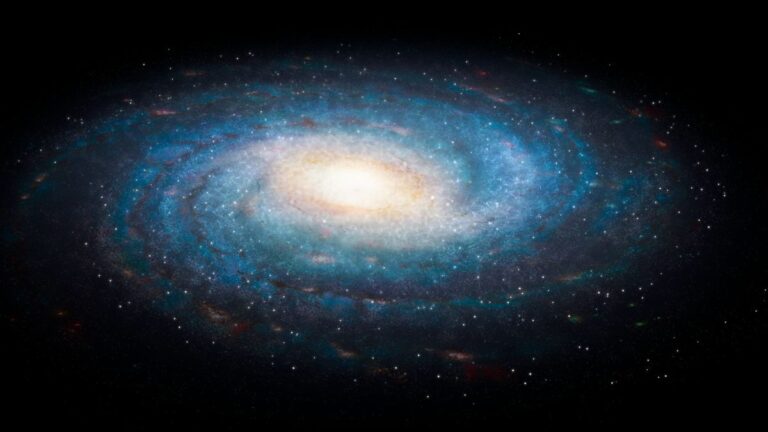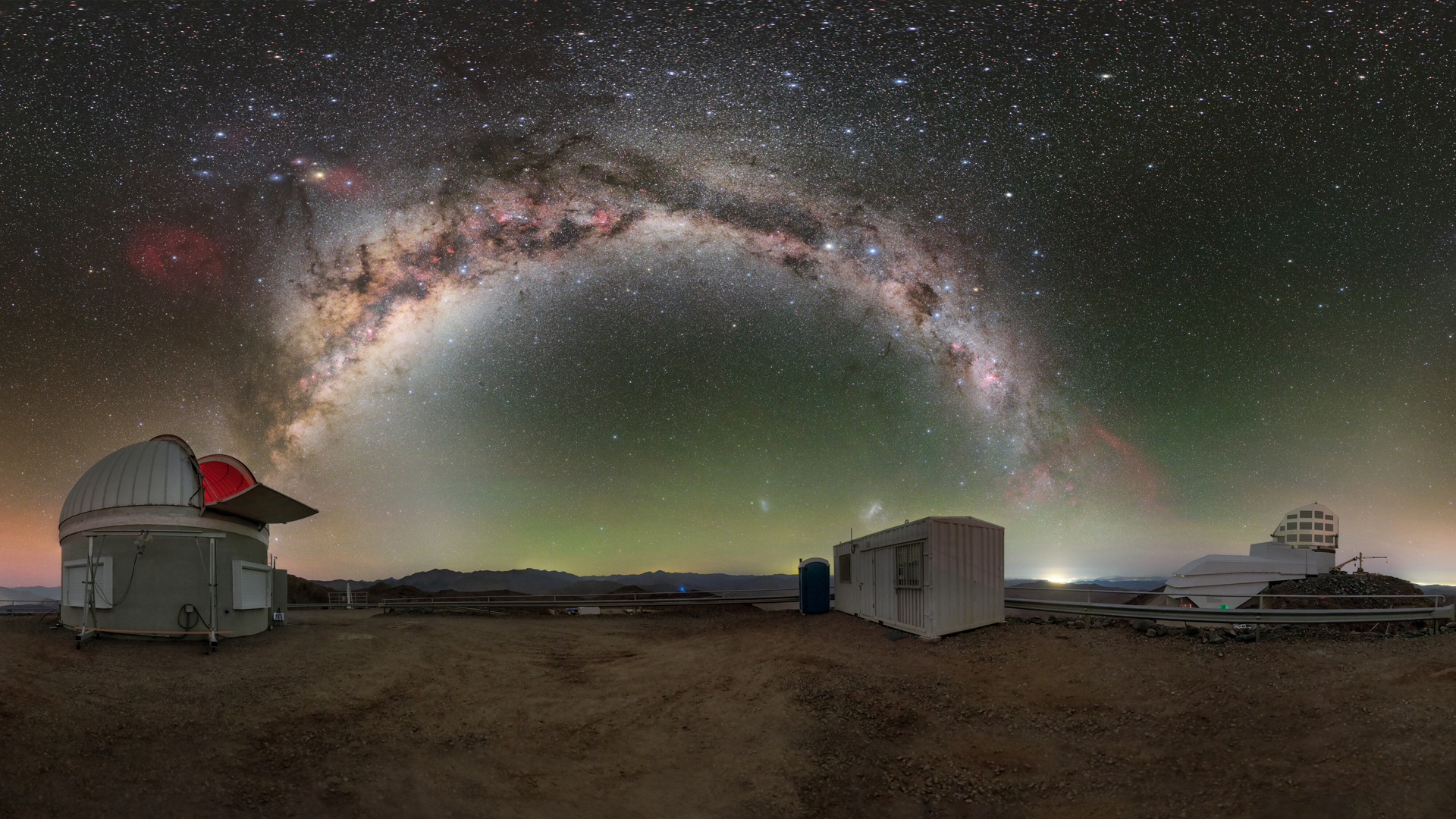
[ad_1]
Astronomers have now deduced what alien scientists might see when they gaze at the Milky Way from afar. The new results suggest our home galaxy is unusual but not unique, at least when it comes to chemistry.
Ever since U.S. astronomer Edwin Hubble discovered that our galaxy is just one among many galaxies about a century ago, researchers have wondered how special (or not) the Milky Way is in the universe, said study co-lead author Jianhui Lian, of the Max Planck Institute for Astronomy in Heidelberg, Germany.
“Finding ways to compare our home galaxy with more distant galaxies is what we need if we want to know whether the Milky Way is special or not,” Lian said in a statement.
Related: The Milky Way galaxy may be a different shape than we thought
The fact that Earth dwells within the Milky Way means scientists know more about it than any other galaxy. For instance, the Milky Way is currently the only spiral galaxy in which astronomers can analyze large numbers of individual stars in terms of their locations, chemistry, temperature and other properties. Measuring how the levels of various chemicals have changed over the course of its history can in turn shed light on how the Milky Way and other galaxies may have grown and evolved over time.
However, until now, scientists had not analyzed how all these chemicals in the Milky Way might look from a distance. Doing so is key to comparing the Milky Way to other galaxies that astronomers have examined from afar.
“To the best of my knowledge, this idea of the ‘alien’s’ view of the Milky Way is rather new,” study co-lead author Maria Bergemann, an astrophysicist also at the Max Planck Institute for Astronomy, told Space.com. “I find it cool and out-of-the-box.”
In the new study, the researchers depended on progress made in the past decade or so to analyze the Milky Way in a systematic manner. For example, the European Space Agency’s Gaia spacecraft has tracked the brightnesses, motions and distances of nearly 1.5 billion stars in the Milky Way.
In addition, there is now much more and much better data for distant galaxies, making it easier to compare the Milky Way to them. For instance, the MaNGA survey analyzed nearly 10,000 galaxies in depth across 2,700 square degrees of the sky. (In comparison, the full moon as seen from Earth covers about 0.5 square degrees.)
The MaNGA survey examined how each galaxy’s chemical composition varies from its center to its outer regions. Furthermore, modern simulations of galaxy formation and evolution can model the history of thousands of galaxies after the Big Bang to the present day. For instance, the TNG50 simulation from scientists in Germany and the United States models a cube of space that is more than 230 million light-years across, tracing the simultaneous evolution of thousands of galaxies across 13.8 billion years of cosmic history.
In the new study, the researchers set out to reconstruct what alien astronomers would see if they were to analyze the Milky Way to map the abundance of what astronomers call “metals” — all elements heavier than the hydrogen and helium that make 99% of all “normal” matter in the universe. (Mysterious dark matter is about six times more common than normal matter, however.)
Related: What is a spiral galaxy?
The Milky Way is shaped like a disk, so the scientists focused on how alien scientists would see the abundance of metals vary within the galaxy. As stars grow, the process of nuclear fusion that helps keep stars alive produces metals within the stars, and when massive stars die in supernova explosions, they expel those metals outward. As such, stars born earlier in time contain fewer metals, whereas later-born stars hold more. Mapping out which regions of a galaxy have stars with fewer metals or more reveals which regions formed its stars earlier and later.
The astronomers also had to account for how interstellar dust can smudge the view of the Milky Way from Earth. This involved combining their observations with known properties of dust and stars to reconstruct the real distribution of stars in the galaxy.
The scientists found that if they tracked the average metal content of stars from the Milky Way’s core outward, it increased, reaching a metal content close to that of our sun at a distance of about 23,000 light-years from the center. (The sun lies about 26,000 light-years from the heart of the galaxy.)
However, at greater distances from the Milky Way’s core, the average metal content drops, reaching about one-third of the sun’s value about 50,000 light-years from the galaxy’s center.
To find out why this belt of metallicity exists, the researchers looked at stars based on their age group. They found that each age group followed a trend where there was greater metal content close to the Milky Way’s core and less metal further out. However, older stars with much lower metal content are more abundant near the heart of the galaxy, while younger stars are more frequent farther out. Averaged out, this led to the pattern of metallicity the scientists detected.
The astronomers then compared the Milky Way with 321 galaxies in the MaNGA survey with masses similar to our galaxy that also feature similar amounts of stars. These galaxies are all also visible face-on, helping the researchers see how metal levels vary across each galaxy. The scientists used these same criteria to identify 134 Milky-Way-like galaxies in the TNG50 simulation.
All in all, the astronomers found that the Milky Way is not common but not unique among galaxies. Only about 1% of the galaxies in the MaNGA sample and 11% of the galaxies in the TNG50 simulation displayed a similar pattern of metals to the Milky Way. They noted that this discrepancy between 1 and 11% may be due to uncertainties in the MaNGA data and limitations of the TNG50 simulation’s accuracy in modeling the universe.
In addition, the team found that the chemical nature of the Milky Way is rare among galaxies of its rough shape and structure.
“The main implication is that our Milky Way is not a typical Milky-Way-like galaxy,” Bergemann said. “In other words, the Milky Way may have evolved differently, compared to others like it.”

When it comes to why the Milky Way appears unusual, the scientists noted that the relative scarcity of metal-rich stars near our galaxy’s center might be related to the formation of the so-called bulge, an approximately spherical region of older stars surrounding the galactic center out to a distance of about 5,000 light-years. The birth of the bulge likely depleted most of the hydrogen gas in the area, making later star formation much more difficult.
But its also possible, the researchers said, that our galaxy’s central supermassive black hole may have at some point become unusually active, spewing out particles and radiation that inhibited star formation.
Team members added that the relative scarcity of metals in the Milky Way’s outer disk could also be explained by a number of different scenarios. For instance, our galaxy might have swallowed a smaller galaxy with gas that contained very few metals. This gas may have later served as the raw material for stars with fewer metals in the Milky Way’s outer disk. The estimates that astronomers currently have for the extent of the Milky Way’s outer disk may also be off, skewing how different the Milky Way appears compared with other galaxies.
In the new study, the researchers focused on iron, since this metal is relatively easy to measure in stars in the Milky Way.
“An interesting research direction would be to try measuring more chemical elements,” Bergemann said. “For example, oxygen, a key element for life on Earth, can also be measured in other galaxies, and we will soon get a lot of data for the chemical evolution of oxygen in the Milky Way — for example from 4MOST [at the Paranal Observatory in Chile.] Another potentially crucial element is carbon.”
The scientists detailed their findings online June 22 in the journal Nature Astronomy.
[ad_2]